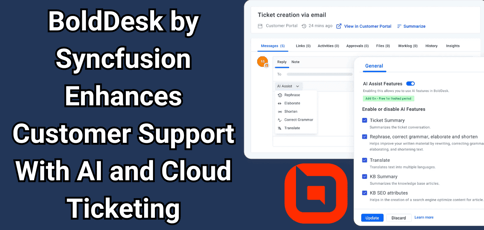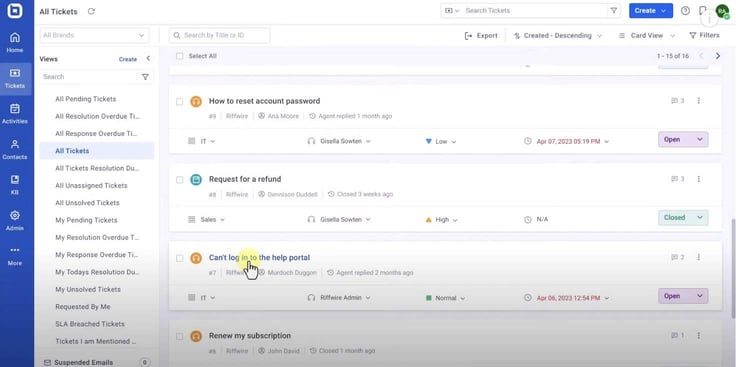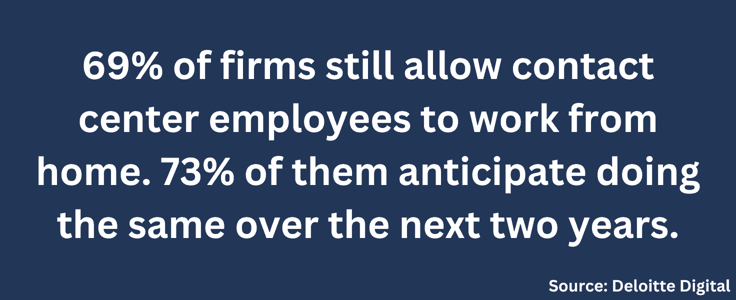
TL; DR: You may already be familiar with Syncfusion. The software company was founded in 2001 and produces toolkits, frameworks, and software to help developers build and improve their computer programs and applications. Daniel Jebaraj, CEO of Syncfusion, told us about the company’s newest product: BoldDesk. BoldDesk is a new customized customer service product featuring an easy-to-use interface with an AI assistant — and it’s here to revolutionize how you manage customer experiences.
Everyone’s been on the customer end of a help desk system. Whether it’s a phone call, an email, a live chat, or a ticket, you know how it works: Fill out the prompt and tell the agent exactly what the problem is.
Unfortunately, when the average company receives nearly 600 tickets per day, it can be hard to prioritize every single request.
I’ve submitted tickets before and never even received a response. It makes me wonder where my request went — maybe it’s just lost in the vast realm of the World Wide Web, seemingly forgotten and unanswered.

But Syncfusion, a software company with more than 20 years of experience, doesn’t let a single ticket fall through the cracks with its brand-new product, BoldDesk.
Daniel Jebaraj, CEO of Syncfusion, demonstrated how BoldDesk streamlines customer management through built-in analytics, seamless task management, and leveraging artificial intelligence (AI) assistance.
Meet BoldDesk, Syncfusion’s Answer to Help Desk Support
Although BoldDesk is a newer product, Daniel says it’s been in the making for approximately 15 years.
Syncfusion is a software company that provides tools, frameworks, and software for developers to build and enhance their computer programs and apps. Before BoldDesk came into fruition, Syncfusion started by building its own help desk to support other business lines.
Combined with consumer requests and new market demands, Syncfusion eventually realized it was a product people wanted. It was refined enough for public release, became BoldDesk, and the rest is history.
Well, sort of. BoldDesk is still evolving into the platform that’s “just right” but isn’t afraid to take some pointers from key players in the industry while holding onto its roots.
Daniel noted there have been few changes in the way consumers experience brands. First, buyer decisions aren’t made based on market reputation; it’s more dynamic now, and people are making decisions based on reviews and what peers say.
“A lot of companies want to differentiate themselves, but there’s so much information at your fingertips that you’re forced to ask all these questions about which is the best choice,” he said.
Daniel also theorized the days of putting customers on hold to wait for the next available agent are long gone because everything is done online. More often than not, customers don’t necessarily want instant resolution: They just want their concerns to be heard.

With that in mind, the BoldDesk features already answer most of the problems agents and managers face without offering an overwhelming amount of data:
- Ticketing system with spam control and brand control
- Enhance internal processes by managing tasks and activities
- Reporting and analytics to enhance your customers’ experience
- Knowledge base to track your customers’ information
- Customize your help desk’s layout, brand, and format
- Integration with your favorite apps, such as Salesforce or Teams
- Automate tasks with customized workflows
- Customer portal to easily send and track tickets
- APIs and webhooks so you can build how you want
“I think Syncfusion has always been a niche, and over the years, it’s become a value provider,” Daniel explained. “So with BoldDesk, we approach this perspective of not trying to compete with existing players on their turf. Instead, we think of the market as expanding beyond its current boundaries.”
This refreshing perspective is something you don’t see too often: From a niche player to a value provider, Syncfusion and BoldDesk are here to cater to the ever-expanding market needs.
Transforming Customer Support with AI-Powered Innovations
There’s no denying AI is the buzzword every CEO, manager, and entrepreneur jumps at. But there’s a good reason: With improved efficiency, data analysis, and even predictive support, AI is changing how companies deliver customer service.
BoldDesk uses a generative AI assistant to improve customers’ experiences by enhancing the agent’s productivity. Here’s how:
- Ticket summarization: Saves time and boosts efficiency with quick summaries of customer conversations, including intent, sentiment, and conversation summaries
- Error-free responses: Ensures professional, grammatically correct answers to enhance customer interactions
- Multilingual support: The AI-powered translation feature allows agents to respond in customers’ native languages, breaking down language barriers
- Knowledge base summaries: Users get concise, condensed summaries of lengthy knowledge base articles for quicker access to information
- SEO enhancement: Get SEO-friendly titles and meta-descriptions for knowledge base articles, improving organic traffic performance
One of Daniel’s favorite aspects of the AI assistant is its ability to suggest professional, error-free conversation based on the customer’s ticket or past experiences.

“The product itself cushions to help empower customers to provide this CRM 360-degree support experience that differentiates who wins and who doesn’t,” he explained. “Before, you would have to provide a block of text to make it work each time, but now, a writing assistant can match the tone or add certain details. This makes it so much easier when dealing with different customers.”
For example, what happens if a customer reaches out and says, “I forgot my password. How do I reset it?”
In that case, the agent may be responsible for manually filling in the context based on the customer’s inquiry, such as: “Dear [Customer], if you [are experiencing this problem], please [step 1], [step 2], and [step 3].”
Imagine doing that more than a hundred times a day. The BoldDesk AI assistant offers automatic prompts right in the text box as the agent starts typing, all tailored to the customer’s inquiry to ensure consistent quality and professionalism. It can also pull information from your internal knowledge base into your agents’ responses.
But BoldDesk doesn’t plan to stop there. Daniel hopes the platform can also better determine future customer intentions based on past experiences.
“It’ll be helpful if we could determine factors like who’s more likely to churn or who might be dissatisfied with the support they’re receiving based on previous interactions or customer feedback,” he said. “We’re not there yet, but I think it’s where we’re headed. Our goal is to always offer more value services on top.”
On the flip side, Daniel also mentioned AI assistance may eventually play a role in operation reporting. This means that users can access reports without creating them from scratch. They can inquire about necessary filters and data requirements, shifting the process to a more user-driven approach.
“We know one more aspect for us is to figure out what kind of work is manual,” Daniel noted. “But AI is becoming increasingly useful, and over time, more will be done.”
BoldDesk’s Plans to Elevate the Customer Support Experience
What’s next for BoldDesk? Chat support improvements.
“Customers prefer a seamless support experience. They want to reach out on platforms, like WhatsApp, and say they’re having an issue without the need for separate apps or websites,” Daniel explained. “Nobody wants to fall through the cracks, so we’re working on a more integrated chat experience.”
As part of its ongoing efforts, BoldDesk has introduced a mobile app to adapt to the increasing number of remote workers and the global nature of modern work. This app allows employees to serve as full support agents, ensuring rapid responses even when not at their desks.

BoldDesk plans to roll out a chat-based interface for users to instruct the AI assistant in managing tasks such as creating activities for tickets. It’s also planning to add more automation to make the user experience smoother by suggesting ways to complete tasks with fewer clicks.
BoldDesk certainly has a bright future as it aims to be a valuable service provider.
It’s as Daniel said: “I think so we’re just getting our feet down, but I can say for sure, we’re constantly improving our infrastructure and optimizing it.”
Try it for free, or book a demo with BoldDesk today.



